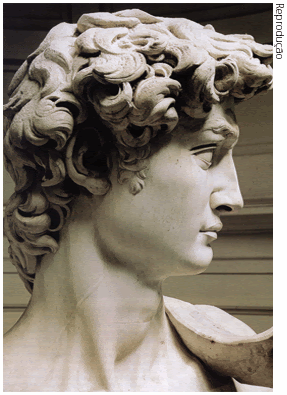 Michelangelo di Lodovico Buonarroti Simoni (Caprese, March 6th, 1475 - Rome, February 18th, 1564) was an Italian Renaissance painter, sculptor, architect, poet and engineer. His versatility in the disciplines he took up was of such a high order that he is often considered a contender for the title of the archetypal Renaissance man.
Michelangelo di Lodovico Buonarroti Simoni (Caprese, March 6th, 1475 - Rome, February 18th, 1564) was an Italian Renaissance painter, sculptor, architect, poet and engineer. His versatility in the disciplines he took up was of such a high order that he is often considered a contender for the title of the archetypal Renaissance man.His David, sculpted from 1501 to 1504, is one of Michelangelo's two greatest works of sculpture, along with the Pietà.
It is the David alone that almost certainly holds the title of the most recognizable statue in the history of art. It has become regarded as a symbol both of strength and youthful human beauty.
 The 5.17 m (17 ft) marble statue portrays the Biblical King David at the moment that he decides to do battle with Goliath. It came to symbolise the Florentine Republic. This interpretation was also encouraged by the original setting of the sculpture outside the Palazzo della Signoria, the seat of civic government in Florence.
The 5.17 m (17 ft) marble statue portrays the Biblical King David at the moment that he decides to do battle with Goliath. It came to symbolise the Florentine Republic. This interpretation was also encouraged by the original setting of the sculpture outside the Palazzo della Signoria, the seat of civic government in Florence.
The completed sculpture was unveiled on September 8th, 1504.
To protect it from damage, the sculpture was moved in 1873 to the Accademia Gallery, and a replica was placed on the Piazza della Signoria in 1910.
Fundamental to Michelangelo's art is his love of male beauty, which attracted him both aesthetically and emotionally. In part, this was an expression of the Renaissance idealization of masculinity, but in Michelangelo's art there is clearly a sensual response to this aesthetic. Such feelings caused him great anguish, and he expressed the struggle between Platonic ideals and carnal desire in his sculpture, drawing and his poetry too, for Michelangelo was also a great lyric poet.
The sculptor's expressions of love have been characterized as both Neoplatonic and openly homoerotic; recent scholarship seeks an interpretation which respects both readings.
One example of the conundrum is the story of the sixteen year old Cecchino dei Bracci, whose death, only a year after their meeting in 1543, inspired the writing of forty eight funeral epigrams, which allude to a relationship that was not only romantic but physical as well:
La carne terra, e qui l'ossa mia, prive
de' lor begli occhi, e del leggiadro aspetto
fan fede a quel ch'i' fu grazia nel letto,
che abbracciava, e' n che l'anima vive.
The flesh now earth, and here my bones,
Bereft of handsome eyes, and jaunty air,
Still loyal are to him I joyed in bed,
Whom I embraced, in whom my soul lives.
The greatest written expression of his love was given to Tommaso dei Cavalieri, who was 23 years old when Michelangelo met him in 1532. Cavalieri was open to the older man's affection: "I swear to return your love. Never have I loved a man more than I love you, never have I wished for a friendship more than I wish for yours." Cavalieri remained devoted to Michelangelo till his death.
Michelangelo dedicated to him over three hundred sonnets and madrigals, constituting the largest sequence of poems composed by him. Their homoerotic nature was recognized in his own time, so that a decorous veil was drawn across them by his grandnephew, who published an edition of the poetry in 1623 – with the gender of pronouns changed…
John Addington Symonds, the early British homosexual activist, undid this change by translating the original sonnets into English and writing a two-volume biography, published in 1893.
The sonnets are the first large sequence of poems in any modern language addressed by one man to another, predating Shakespeare's sonnets to his young friend by a good fifty years.
 Prudishness in the era of advertising?!
Prudishness in the era of advertising?!I feel as lit by fire a cold countenance
That burns me from afar and keeps itself ice-chill;
A strength I feel two shapely arms to fill
Which without motion moves every balance.
Through his poetry and visual art we may glimpse the arc of his imagination…
RIC & Wikipedia
Muito obrigado, Paulo, pela tua estimulante sugestão!
Mais um Setembro que termina.
A uns, «olá, bem-vindos»
A outros, «adeus, até um dia»
Que o mundo não tem como parar…




















































